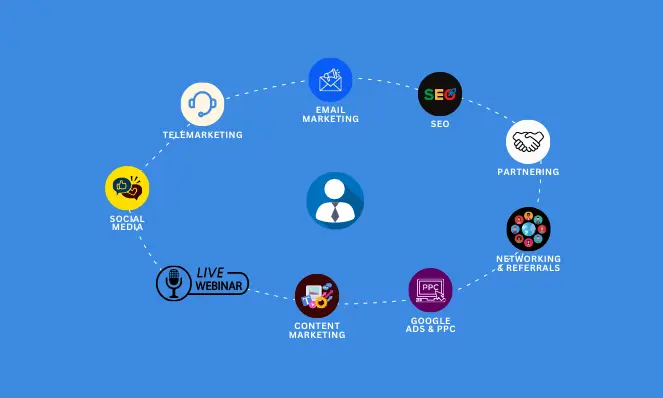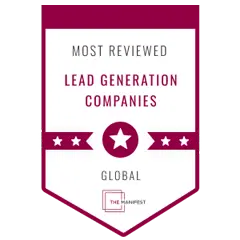Let’s face it – the manufacturing and distribution industry is in a race against time. The industry is always on the move, with new technologies, changing consumer preferences, and fierce competition shaping the market.
Numbers don’t lie.
According to a report by Accenture, only 13% of manufacturers feel that they’re advanced in their use of digital technologies, while 62% are still trying to adapt. What’s more? A study by Deloitte found that 60% of manufacturers believe their products will be commoditized within five years, highlighting the need for differentiation and innovation.
Yes, manufacturing and distribution businesses have top-quality products, but without effective sales strategies, you have the risk of falling behind in a competitive market. In fact, Aberdeen Group’s recent research shows that 70% of manufacturing sales teams fail to meet their quotas, highlighting the need for effective sales strategies that can drive revenue and boost profitability.
These statistics clearly indicate that the manufacturing and distribution industry is struggling to keep up with the pace of change. But with challenges come opportunities. So, how can you stand out and achieve sales in the manufacturing and distribution industry?
Through Lead Generation for Manufacturers and Distribution!
While developing a manufacturing sales strategy takes time, there are some strategies you can start doing. In this article, we’ll discuss the lead generation strategies for manufacturing and distribution companies you can use to increase manufacturing sales, which include:
- Ways to Increase Sales in Manufacturing and Distribution
- Global Sales Strategy for Manufacturing and Distribution Industry
Ways to Increase Sales in Manufacturing and Distribution
To increase sales in your manufacturing company, it’s important to align your strategies with the specific needs and preferences of your target audience. Here are some strategies to consider to increase sales in a manufacturing company:
- Understand Your Buyer Personas
The first thing you need to do to increase your sales is to develop detailed buyer personas for manufacturing leads that represent the key decision-makers and influencers in your target industries or sectors. It is also equally important that you Identify your prospect’s pain points, motivations, and buying preferences. This understanding will guide your sales and marketing efforts.
- Tailor Your Messaging
Craft sales messages and value propositions that directly address the pain points and goals of your buyer personas. Use language and terminology that resonate with them, demonstrating your understanding of their unique manufacturing challenges and offering solutions.
- Showcase Industry Expertise
Establish your manufacturing company as an industry expert by sharing valuable content, insights, and thought leadership. Publish blog posts, whitepapers, case studies, and videos that address common manufacturing challenges and provide practical solutions.
- Offer Customization and Personalization
Highlight your ability to customize your manufacturing products to meet the specific needs of your buyer personas. Showcase successful case studies or examples where you have provided tailored solutions for similar clients in their industry.
- Provide Exceptional Customer Service
In the manufacturing industry, strong customer relationships are crucial. So, prioritize responsive and personalized customer service throughout the sales process and beyond. Address inquiries promptly, provide accurate information, and offer ongoing support to foster long-term customer loyalty.
- Leverage Testimonials and Success Stories
Collect testimonials and success stories from satisfied customers within your target industries. Highlight how your manufacturing solutions have addressed their pain points, improved efficiency, or positively impacted their business. Share these stories on your website, in sales presentations, and through other marketing channels.
- Continuous Improvement and Innovation
Stay ahead of the competition by continually improving your manufacturing processes, products, and technology. Stay updated on industry trends, invest in research and development, and proactively offer innovative solutions that align with the evolving needs of your buyer personas.
- Monitor and Analyze Sales Data
Track and analyze sales data to gain insights into the effectiveness of your sales strategies for different buyer personas. Identify patterns, trends, and areas of improvement to optimize your sales efforts and allocate resources more efficiently.
By implementing these strategies and prioritizing the specific needs and preferences of your buyer personas for manufacturing, you can enhance your sales efforts and drive growth in your manufacturing company.
Global Sales Strategy for Manufacturing and Distribution Industry
The global manufacturing sales strategy for the manufacturing and distribution industry involves developing a comprehensive plan to expand market reach, increase sales, and build strong relationships with customers and partners on a global scale.
How to Generate Manufacturing Leads Through Multiple Channels?

Generating B2B leads for manufacturing can be a highly competitive and challenging task. But with the right approach and multi-channel marketing, you can expand your reach to a wider audience and increase your chances of converting leads into customers.
Here are the most effective approach for your manufacturing B2B lead generation approach:
- Email marketing: Email marketing remains one of the most effective ways to generate leads. Create a targeted email campaign that highlights your manufacturing expertise and services. Make sure to include a clear call-to-action that encourages recipients to contact you for more information.
- Telemarketing: Telemarketing is one of the best ways to generate leads by reaching out to potential customers directly. SMART Calling, to be exact, can be an effective strategy for reaching potential customers and converting them into leads. By developing a targeted list of leads and delivering personalized messages, you can build a connection with potential customers and increase your chances of generating more business.
- Social media: Social media platforms, like LinkedIn, can be an effective way to reach your potential customers. Make sure to post regularly, including valuable content about your manufacturing capabilities, case studies, and testimonials. Responding to inquiries and comments can also help you to build trust with your potential customers.
Related: Lead Generation on LinkedIn: 11 Proven Ways to Secure Qualified Leads - Webinars/Live Events: Hosting webinars or live events can help to establish your company as a thought leader in the manufacturing industry. It provides an opportunity to showcase your expertise and services, connect with potential customers, and generate leads.
- Content Marketing: Creating and promoting content that showcases your manufacturing expertise can help attract potential leads. This could include blog posts, whitepapers, case studies, webinars, and more.
- Google Ads and pay-per-click (PPC): Consider running PPC ads on search engines or social media platforms to target potential leads with specific messaging and promotions. Paid marketing campaigns can help your business get into search engine results pages (SERP) in minutes, but make sure that your ad content is effective. It includes conducting research to determine which keywords to target and how your buyer personas would search online.
- Networking and Referrals: Attend industry events and conferences to connect with potential leads and build relationships. Encourage satisfied customers to refer new leads to your business.
- Partnering with Resellers and Distributors: Partnering with resellers and distributors can help you reach new audiences and generate leads through their existing networks.
- Search Engine Optimization (SEO): Optimizing your website for search engines can help potential leads find your business online. Focus on creating content with relevant keywords and meta descriptions to improve your website’s visibility in search results.
Implementing the right approach for your manufacturing and distribution business can surely expand your reach and boost your manufacturing sales. With persistence and the right strategy, you can turn those leads into loyal customers and grow your business.
How to Develop a Customer-Centric Approach?
If you have a business – be it the manufacturing and distribution or logistics industry, you need to focus on building strong relationships with your customers. By understanding your customers’ needs, preferences, and pain points, you can tailor your products and services to meet their specific requirements. This approach not only increases customer satisfaction but also helps your businesses to build customer loyalty. To develop a customer-centric approach for your manufacturing business, you need to:
- Define your target audience: Identify the demographics, needs, and pain points of your ideal customers. This will help you create products and services that meet their specific needs.
Related: How Customer Profiles and Buyer Personas Drive Your Lead Gen Campaign - Gather customer feedback: Customer feedback is essential in developing a customer-centric approach. Conduct surveys, interviews, and focus groups to understand your customers’ needs and preferences. Use this feedback to make improvements to your products and services.
- Create customer personas: Creating customer personas is an effective way to visualize your target audience. Develop fictional characters that represent your ideal customers. Include details such as their age, occupation, and buying behavior. Use these personas to guide your decision-making process.
- Train your staff to provide exceptional customer service: Your employees are the face of your business, and they should be trained to provide exceptional customer service. Teach them to listen to customer feedback, answer questions, and resolve issues promptly. Empower them to make decisions that benefit the customer.
- Offer customized products and services: Customization is a key component of a customer-centric approach. Offer products and services that can be customized to meet the specific needs and preferences of your customers. This will help you differentiate yourself from your competitors and build customer loyalty.
- Use customer data to drive decisions: Leverage customer data to make informed decisions. Use data analytics to track customer behavior and buying patterns. This information can help you make improvements to your products and services, pricing strategy, and marketing campaigns.
- Continuously improve based on customer feedback and industry trends: A customer-centric approach requires continuous improvement. Stay up-to-date with the latest trends and technologies in your industry. Monitor customer feedback and make changes accordingly. The more you focus on improving the customer experience, the more loyal and satisfied your customers will be.
Developing a customer-centric approach is essential for the success of your manufacturing businesses. But by using customer data to drive decisions, and continuously improving, you can build strong relationships with your customers and stay ahead of the competition.
Obviously, there are many factors that drive your manufacturing leads buying journey before they become a customer of your business. To convert these prospects into customers, you need to know how they arrive at the buying decision. To learn the best way how to move your manufacturing sales prospects along the buying journey, you can read: Industry Insights: What Drives Manufacturing Leads’ Buying Journey?
How to Embrace Product Customization?
Product customization has become increasingly important in the manufacturing industry as customers demand products that meet their unique needs and preferences. Here’s how you can embrace product customization:
- Analyze Customer Needs and Preferences: You should start by analyzing your customer’s needs and preferences to determine the customization options that will appeal to them. This can be done through market research, surveys, and customer feedback.
- Develop a Flexible Manufacturing Process: To offer customization options, your company needs to have a flexible manufacturing process. This may involve investing in new equipment, software, and systems that can handle customized orders efficiently.
- Offer a Wide Range of Customization Options: You should offer a wide range of customization options to appeal to a broad customer base. This may include options such as colors, materials, sizes, and features that your customers can select to personalize their products.
- Streamline the Ordering and Production Process: The customization process should be streamlined to ensure that it is efficient and cost-effective. This may involve automating the ordering process, using digital tools to design and visualize customized products, and implementing lean manufacturing principles to optimize the production process.
- Communicate Clearly with Customers: You should communicate clearly with customers about the customization options available, the production process, and the expected delivery times. This will help to manage customer expectations and ensure that they are satisfied with the final product.
Related: Top 5 Ways To Communicate More Effectively With Customers - Ensure Quality Control: Quality control is critical in the customization process. You should ensure that the customized products meet the same quality standards as their standard products. This may involve additional quality checks and testing to ensure that the customized products are safe and meet the customer’s requirements.
- Continuously Improve: You should also continuously seek feedback from customers and analyze data to improve your customization options and processes. This will help you stay ahead of the competition and meet your customers’ evolving needs.
How to Nurture Customers’ Loyalty?
When you are in the manufacturing and distribution industry long enough, you’ll surely understand why nurturing customer loyalty is more crucial than ever. With so many competitors vying for their attention, it can be challenging to retain customers and maintain a steady stream of sales.
That’s why nurturing customer loyalty is more crucial than ever. By building strong relationships with your customers, you can create a loyal customer base that repeatedly chooses your brand. This leads to increased sales, customer retention, and positive word-of-mouth marketing.
Here are some effective ways to do so:
- Provide excellent customer service: Just like in any other business industry, exceptional customer service is crucial in manufacturing and distribution. This means going above and beyond to meet your customers’ needs and expectations. It’s important to be responsive to their inquiries, address their concerns promptly, and be transparent about any issues that arise. By providing excellent customer service, you can build trust and loyalty with your customers.
- Offer customized solutions: Every customer is unique, with their own specific needs and challenges. Offering customized solutions that cater to each customer’s needs can help you stand out from the competition. Take the time to understand your customers’ requirements, and work with them to develop tailored solutions that meet their needs.
- Build strong relationships: Building relationships with your customers is a great way to foster long-term loyalty. This means staying in touch with them regularly, not just because you need to make a sale. You can do this by sending them personalized emails, inviting them to events, and even sending them small gifts on occasion. By building rapport with your customers, you can create a strong foundation for long-lasting loyalty.
- Provide ongoing support: Once you’ve made a sale, it’s important to continue providing support to your customers. This means being available to answer any questions they may have and providing ongoing support and guidance as needed. By being there for your customers throughout their entire journey, you can build a strong sense of trust and loyalty.
- Offer incentives and rewards: Finally, offering incentives and rewards can be an effective way to nurture customer loyalty. This could include discounts on future purchases, exclusive access to new products or services, or even loyalty programs that offer special perks to repeat customers. By providing these incentives, you can encourage your customers to continue doing business with you, and foster a sense of appreciation and loyalty.
In Conclusion
The manufacturing industry is at an exciting crossroads, where technological advancements and shifting consumer demands are creating new opportunities for growth and innovation. However, in order to stay ahead of the curve, it’s important for you to stay informed and up-to-date on the latest strategies, trends, and developments in your field.
As a manufacturing industry professional, you have a unique opportunity to drive change and shape the future of your industry. So, take advantage of it! Attend industry events, connect with peers and experts, and explore new technologies and processes. By staying curious and adaptable, you can position yourself and your organization for success in the years to come.
Are you ready to take your business to the next level?











